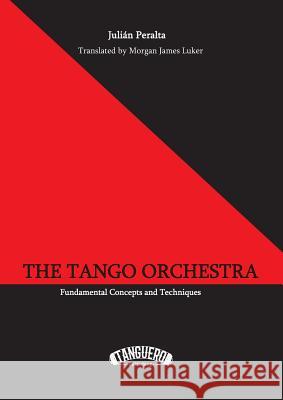The Tango Orchestra: Fundamental Concepts and Techniques » książka
The Tango Orchestra: Fundamental Concepts and Techniques
ISBN-13: 9780997489309 / Angielski / Miękka / 2016 / 250 str.
The Tango Orchestra: Fundamental Concepts and Techniques
By Julian Peralta
Translated by Morgan James Luker Written by one of tango music's most active contemporary orchestra leaders and composers, this book presents for the first time a comprehensive anatomy of the theory and techniques of tango arranging. Included are traditional accompaniment patterns; rules for voicing of parts; typical tango articulations and performance techniques for all instruments used in tango; and strategies for melodic and rhythmic permutation. The book prepares the tango composer or arranger with a solid grounding in traditional tango harmony and orchestration, illustrating the common practices of arrangers of the major 20th century tango orchestras. More than 400 musical examples represent a wide range of composers and arrangers, such as Canaro, De Caro, Di Sarli, Federico, Firpo, Fresedo, Gardel, Gobbi, Laurenz, Piazzolla, Plaza, Pontier, Pugliese, Salgan, Troilo, and others. Excerpts of scores for full orchestra, and a complete 12-instrument orchestration of a tango are provided for analysis. Julian Peralta is the central catalyst behind the new orquesta tipica movement in Buenos Aires. He has directed dozens of contemporary tango orchestras, including Orquesta Fernandez Fierro, Astillero, and Orquesta TIpica JuliAn Peralta. He teaches at Escuela de Musica Popular de Avellaneda, Escuela de Tango Orlando GoNi, and the Tanguero Workshop. In The Tango Orchestra: Fundamental Concepts and Techniques, Peralta shares the knowledge he has gained from more than 20 years of studying the literature of the tango orchestra. It is a "must read" for anyone who intends to study tango seriously.
The Tango Orchestra: Fundamental Concepts and Techniques
By Julian Peralta
Translated by Morgan James LukerWritten by one of tango music’s most active contemporary orchestra leaders and composers, this book presents for the first time a comprehensive anatomy of the theory and techniques of tango arranging.Included are traditional accompaniment patterns; rules for voicing of parts; typical tango articulations and performance techniques for all instruments used in tango; and strategies for melodic and rhythmic permutation.The book prepares the tango composer or arranger with a solid grounding in traditional tango harmony and orchestration, illustrating the common practices of arrangers of the major 20th century tango orchestras.More than 400 musical examples represent a wide range of composers and arrangers, such as Canaro, De Caro, Di Sarli, Federico, Firpo, Fresedo, Gardel, Gobbi, Laurenz, Piazzolla, Plaza, Pontier, Pugliese, Salgan, Troilo, and others. Excerpts of scores for full orchestra, and a complete 12-instrument orchestration of a tango are provided for analysis.Julian Peralta is the central catalyst behind the new orquesta tipica movement in Buenos Aires. He has directed dozens of contemporary tango orchestras, including Orquesta Fernandez Fierro, Astillero, and Orquesta Típica Julián Peralta. He teaches at Escuela de Musica Popular de Avellaneda, Escuela de Tango Orlando Goñi, and the Tanguero Workshop.In The Tango Orchestra: Fundamental Concepts and Techniques, Peralta shares the knowledge he has gained from more than 20 years of studying the literature of the tango orchestra. It is a “must read” for anyone who intends to study tango seriously.











